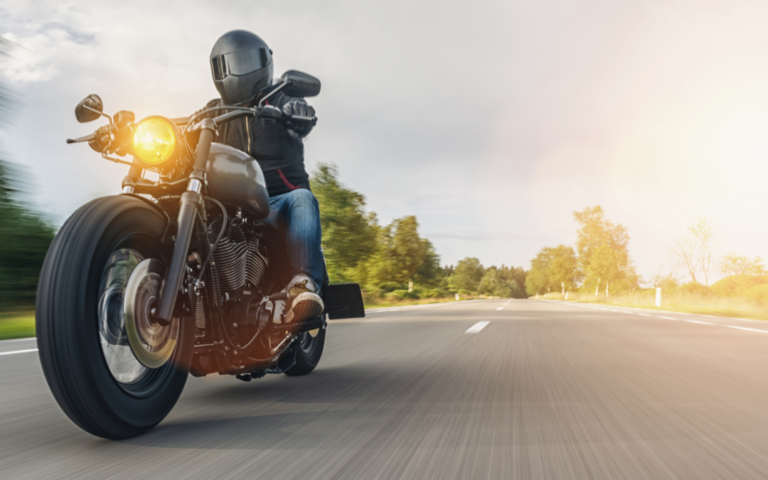Motorcyclists use dipped headlights (low beams) during daylight to enhance their visibility on the road, reducing the risk of accidents. This practice is not only for safety but also for legal compliance in some regions. Many modern motorcycles come equipped with daytime running lights (DRLs) to make them more conspicuous.
Furthermore, using headlights during the day is especially important in adverse weather conditions and when the sun is low in the sky. It has become a common and essential habit for motorcyclists to improve their safety and reduce the likelihood of accidents.
How do dipped headlights enhance motorcycle visibility?

The use of dipped headlights during daylight on motorcycles significantly enhances their visibility to other road users, reducing the risk of accidents.
Enhanced visibility to other road users
Motorcycles are smaller and less conspicuous than larger vehicles like cars and trucks. Using dipped headlights during daylight hours significantly increases a motorcycle’s visibility to other road users.
The human eye is naturally drawn to sources of light, so the use of headlights makes a motorcycle stand out, especially in complex traffic situations or at intersections.
Headlights create a visual contrast against the background, making it easier for drivers of other vehicles to notice and track the motorcycle’s position.
Reducing the risk of accidents
One of the most critical aspects of motorcycle safety is ensuring that the rider is seen by other road users. Accidents often occur when drivers fail to detect motorcycles in their vicinity.
Using headlights during the day reduces the chances of being involved in a collision due to another driver failing to see the motorcycle. This practice gives riders more time to react to potential hazards.
Studies have shown that the use of daytime running lights (DRLs) or headlights during the day can lead to a substantial reduction in the number of motorcycle accidents and fatalities.
Legal requirements in some regions
Many countries and regions have specific laws and regulations that mandate the use of headlights or daytime running lights on motorcycles during daylight hours.
These legal requirements are aimed at improving road safety by ensuring that motorcycles are as visible as possible. Violating these laws can result in fines and penalties.
Furthermore, the specifics of these regulations, such as when and where headlights should be used, can vary by jurisdiction, so motorcyclists must be aware of and adhere to the rules in their area to avoid legal consequences.
Why are DRLs used on motorcycles?
Daytime Running Lights (DRLs) are low-intensity front lights that operate during daylight hours to enhance motorcycle visibility.
Description and purpose of DRLs
Daytime Running Lights (DRLs) are low-intensity front lights that are designed to be on whenever the motorcycle is in operation during daylight hours. They are typically positioned at the front of the motorcycle.
The primary purpose of DRLs is to enhance the visibility of the motorcycle to other road users. They are distinct from the main headlights, which are typically more intense and used during reduced visibility conditions like darkness or inclement weather.
DRLs are engineered to consume less energy compared to full headlights, which makes them energy-efficient and suitable for continuous use.
Their role in improving motorcycle visibility
DRLs play a crucial role in increasing the conspicuity of motorcycles on the road. Their constant operation during daylight makes motorcycles more noticeable to other drivers, pedestrians, and cyclists.
DRLs are designed to emit a distinct and easily recognizable light pattern, which helps differentiate motorcycles from other vehicles and objects in traffic.
The use of DRLs has been shown to be highly effective in reducing the likelihood of motorcycle accidents. Studies indicate that motorcycles equipped with DRLs are more likely to be seen by other drivers, especially at intersections and in situations where there are visual distractions.
Additionally, DRLs contribute to motorcycle safety by reducing the risk of rear-end collisions. The illuminated front end of the motorcycle is more likely to catch the attention of drivers approaching from behind.
Some modern motorcycles come with advanced DRL systems that automatically adjust their intensity in response to ambient light conditions. This ensures optimal visibility without being overly bright and potentially blinding to other road users during nighttime or in well-lit areas.
How do weather and sun angle impact motorcycle safety?
Adverse weather conditions, including fog, rain, and snow, can severely impact visibility on the road, and motorcycles are at a heightened risk in these situations.
Influence of adverse weather on visibility
Adverse weather conditions such as rain, fog, and snow can significantly reduce visibility on the road. Motorcycles, being smaller and less visible than cars, are particularly vulnerable in these situations.
Rain and fog can scatter and absorb light, making it difficult for other road users to see motorcycles. The moisture in the air can also create a hazy or distorted visual environment.
Snow can further reduce visibility and create additional hazards, especially when it accumulates on the motorcycle and its lights.
Significance of using headlights during foggy or overcast conditions
During foggy or overcast conditions, using headlights becomes especially important for motorcycles. Headlights cut through the fog and make the motorcycle more visible to other drivers.
In fog, the light from headlights can reflect off the water droplets in the air, making the motorcycle appear more substantial and distinct.
Using headlights in overcast conditions, even during the day, can help compensate for the lack of natural light, ensuring that the motorcycle remains conspicuous to other road users.
Headlights as aids in situations with a low sun angle
Low sun angles, such as during sunrise or sunset, can create blinding glare for both motorcyclists and other drivers. This glare can impair vision and make it challenging to see objects on the road.
In such situations, using headlights on motorcycles can be a two-fold benefit. First, it makes the motorcycle more visible by creating contrast against the glare. Second, it can reduce the risk of being overlooked due to the challenging lighting conditions.
Additionally, the use of headlights during low sun angles can help signal to other drivers that the motorcycle is on the road, which is crucial in avoiding right-of-way violations.
How is the tradition of using daytime headlights?

The habit of using headlights during the day is deeply ingrained in motorcycle culture and represents a commitment to safety.
The habit of using headlights during the day among motorcyclists
Using headlights during the day has become a well-established and common practice among motorcyclists worldwide. It is often considered a habitual part of safe riding.
Many motorcyclists adopt this practice as a matter of course and may not even think about it consciously. It is often instilled as a fundamental aspect of motorcycle safety during rider training and education.
Motorcyclists may switch on their headlights every time they start their bikes, forming a routine that helps ensure they are always visible on the road.
Cultural and safety significance of this practice
Using headlights during the day has both cultural and safety significance. It represents a shared understanding among motorcyclists of the unique challenges they face on the road.
Culturally, it is a sign of solidarity among motorcyclists, demonstrating their commitment to safety and their consideration for one another. It’s a way of saying, “I’m a fellow rider, and I want to make sure you see me.”
Safety-wise, the practice is a proactive approach to mitigating the inherent risks associated with riding a motorcycle. It aligns with the broader motorcycle safety culture that emphasizes defensive riding and taking precautions to reduce the chances of accidents.
Some motorcycle clubs and organizations actively promote the use of headlights during the day as a safety measure, encouraging members to set an example for responsible and safe riding.
Additionally, the cultural significance of this practice often transcends borders and language barriers, making it a universal norm among motorcyclists.
FAQ’s
Is using dipped headlights during the day a legal requirement?
In many places, yes. It’s a rule to improve safety.
How do daytime running lights (DRLs) work on motorcycles?
DRLs are low-intensity lights that are always on during the day to increase visibility.
Why do motorcyclists use headlights during the day even when it’s sunny?
It helps others notice them and is a safety tradition.
Do weather conditions affect the need for headlights during the day?
Yes, in fog, rain, or when the sun is low, it’s even more crucial for safety.
What’s the cultural significance of using headlights?
It’s a symbol of unity and responsibility within the motorcycle community, emphasizing safety.
Final Words
Using headlights during the day helps keep motorcyclists safe. It makes them easier to see and reduces the chance of accidents. Some places even make it a rule. Special daytime lights on motorcycles do a similar job, adding to safety. When the weather’s bad or the sun is low, headlights are even more important.
Many motorcyclists always do this because it’s a tradition and a way to show they care about safety. It’s not just following the rules; it’s about being part of a community that looks out for each other. So, using headlights during the day is a big deal for motorcycle safety.

